Showing 97–112 of 116 results
-
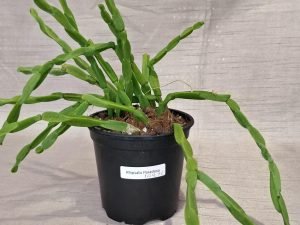
Rhipsalis Paradoxa
Read more🍍The plant is a tropical perennial epiphyte. The Rhipsalis Chain can grow as long as about 5 to 15 meters. Importantly, the length of the plant depends upon the growth conditions and space provided to the plant.
The plant produces numerous tiny white blooms along the length of the branches. The flowers are about 0.5 inches in diameter, have yellowish black petals, unscented and non-showy in nature. Bloom season starts from late winter and continues until the early days of spring. The plant produces small red fruits. Although they look attractive but wait! Don’t feel tempted to eat them as they are inedible. -

Rhipsalis Paradoxa (Extra Large)
Read moreRhipsalis Paradoxa is a forest succulent that is an epiphyte in nature and grows in the form of long, beautiful, chain-like vines that hang from their pot and look untidy, yet gorgeous. These are one of the most beautiful species from the cactus family of plants and are, unfortunately, expected to become extinct if the habitat loss persists at the same rate as it is now.
-

Rhipsalis Paradoxa (Medium)
Read moreRhipsalis is the largest and most diverse genus of epiphytic cactus plants. Members of this genus are around 30 to 60 in number and are popularly known as Mistletoe Cacti. Joseph Gaertner described this Brazilian native oldest genus of flowering cacti in 1788.
The majority of the plants grow as pendulous epiphytes, while a few are epilithic and terrestrial growers. Furthermore, the stems of the Rhipsalis plants are succulent in nature. However, the extent of succulence is variable among the species. As far as appearance is concerned, the stem shape of the plants can be terete, angular, or flat.
-
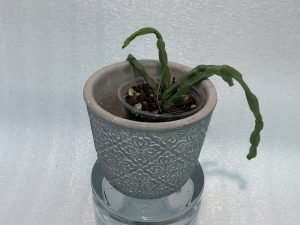
Rhipsalis Paradoxa (Small)
Read moreRhipsalis Paradoxa is a unique cactus discovered by Joseph Salm-Reifferscheidt-Dyck in 1845. This evergreen cascading succulent forms green and dandy branches about 1 inch wide and can grow meters long. The leaves are attached in an unusual way making links and joined at right angles.
-
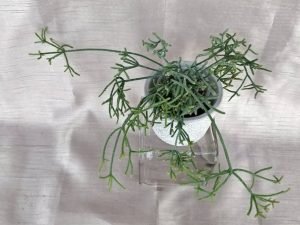
Rhipsalis Pilocarpa
Read more🌿🌿🌿Rhipsalis pilocarpa also called as the hairy-fruited wickerware cactus. The plants main feature is the long green stem that grows in every direction often lighter green around the tips.🌿🌿🌿
🌿🌿The hairy-fruited wickerware cactus blooms with very fragrant, opening slowly, up to 2 cm broad flowers that appear alone or in pairs at ends of terminal branches. The pericarp is covered with bristle-like spines. The wine-red, berry-shaped fruits are spherical and studded with bristle-like spines. The fruits contain quite large, black seeds.🌿🌿
-
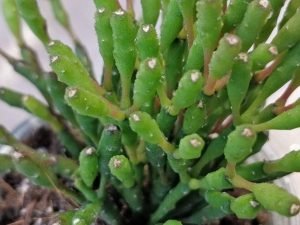
Rhipsalis Salicarnioides | TropicalXay
Read more💚💚Rhipsalis Salicarnioides is a slender, erect, arching or somewhat pendent, bushy, cactus with unique jointed stems and many small yellow-orange flowers. It can be either epiphytic or terrestrial, but is commonly grown as a foliage plant. The plant is made of many-branched stems and reaches 30-60(-100) cm in height and spread. It is said that it deserves first place among the Cacti of easy culture.💚💚
Other common name for this plant are ‘Dancing Bones, ‘Drunkard’s Dream’, ‘Bottle Cactus’.
-
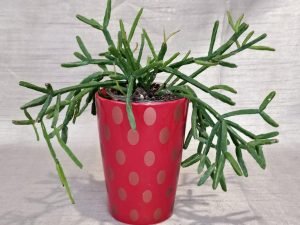
Rhipsalis Trigona
Read more☀☀Rhipsalis Trigona is a pendant much-branched ephiphytic cactus that can reach upto 6.6 feet in length. the stems segments are stout, 3-angled, often curved or twisted. It has white or pale pink flowers.☀☀
-

Scindapsus Dark Form
Read moreScindapsus Treubii Dark Form is a rare and beautiful looking vining species of scindapsus with large nearly black leaves.
-

Scindapsus Pictus ‘Silver Lady’ (3 Leaves)
Read moreScindapsus Pictus ‘Silver Lady’ have leaves that are large & narrower than other types of Scindapsus. The dappled foliage is covered with a silver sheen and speckles or splashes of deep green on the remaining portion. This is a unique, reverse coloration than more common varieties. Grow in bright, indirect light. Use a well draining potting mix when repotting. Water only when soil has dried completely.
-
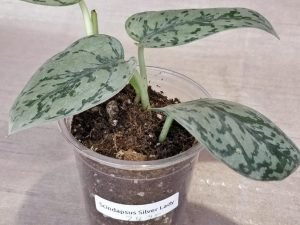
Scindapsus Pictus ‘Silver Lady’ (4 Leaves)
Read moreScindapsus Pictus ‘Silver Lady’ have leaves that are large & narrower than other types of Scindapsus. The dappled foliage is covered with a silver sheen and speckles or splashes of deep green on the remaining portion. This is a unique, reverse coloration than more common varieties. Grow in bright, indirect light. Use a well draining potting mix when repotting. Water only when soil has dried completely.
-

Scindapsus Pictus ‘Silver Lady’ (5 Leaves)
Read moreScindapsus Pictus ‘Silver Lady’ have leaves that are large & narrower than other types of Scindapsus. The dappled foliage is covered with a silver sheen and speckles or splashes of deep green on the remaining portion. This is a unique, reverse coloration than more common varieties. Grow in bright, indirect light. Use a well draining potting mix when repotting. Water only when soil has dried completely.
-

Scindapsus Treubii – Moonlight (Large)
Read moreScindapsus Treubii Moonlight is a rare, green houseplant with milky green leaves with a hint of silver in the center of the leave. These plants are trailing and climbing in nature, so they appreciate external support to climb on to. You may use brass support or a bamboo stick. Giving them external support can make their leaves grow efficiently.
Interestingly, not only are these plants pretty to look at, but they are also very beneficial to be added to our homes. According to NASA, these plants can clear the air of many pollutants such as formaldehyde, which is present almost everywhere in our houses, the carpets, the furniture, you name it.
-

Scindapsus Treubii – Moonlight (Small)
Read moreScindapsus Treubii Moonlight is a rare, green houseplant with milky green leaves with a hint of silver in the center of the leave. These plants are trailing and climbing in nature, so they appreciate external support to climb on to. You may use brass support or a bamboo stick. Giving them external support can make their leaves grow efficiently.
Interestingly, not only are these plants pretty to look at, but they are also very beneficial to be added to our homes. According to NASA, these plants can clear the air of many pollutants such as formaldehyde, which is present almost everywhere in our houses, the carpets, the furniture, you name it.
-
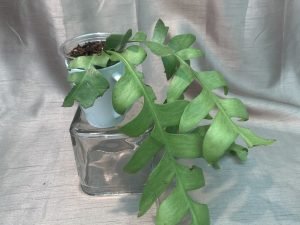
Selenicereus Cheysocardium – Fern Leaf Cactus (Medium)
Read moreSelenicereus Chrysocardium also known as Fern Leaf (orchid) Cactus is native to Mexico. Formerly know as Epiphyllum Chrysocardium, it is an epiphytic, spineless cactus and can grow up to 1.8m wide with branching stems holding long, pale green leaves. They are technically called Cladodes, that have rounded lobes in a zig-zag pattern. It can produce huge, beautiful white flowers with long, golden stamen filaments but it is pretty shy blooming so don’t expect to see these often (or at all)
-

Selenicereus Chrysocadium – Fern Leaf Cactus (Small)
Read moreSelenicereus Chrysocardium also known as Fern Leaf (orchid) Cactus is native to Mexico. Formerly know as Epiphyllum Chrysocardium, it is an epiphytic, spineless cactus and can grow up to 1.8m wide with branching stems holding long, pale green leaves. They are technically called Cladodes, that have rounded lobes in a zig-zag pattern. It can produce huge, beautiful white flowers with long, golden stamen filaments but it is pretty shy blooming so don’t expect to see these often (or at all)
-

Selenicereus Chrysocardium – Fern Leaf Cactus (Large)
Read moreSelenicereus Chrysocardium also known as Fern Leaf (Orchid) Cactus is native to Mexico. Formerly know as Epiphyllum Chrysocardium, it is an epiphytic, spineless cactus and can grow up to 1.8m wide with branching stems holding long, pale green leaves. They are technically called Cladodes, that have rounded lobes in a zig-zag pattern. It can produce huge, beautiful white flowers with long, golden stamen filaments but it is pretty shy blooming so don’t expect to see these often or at all.
